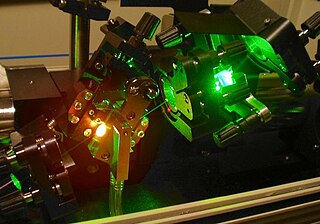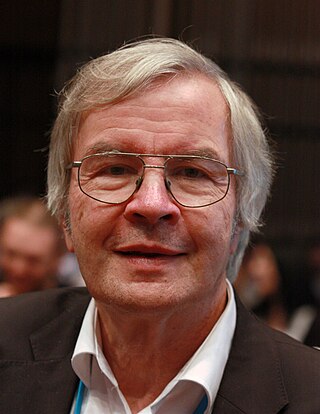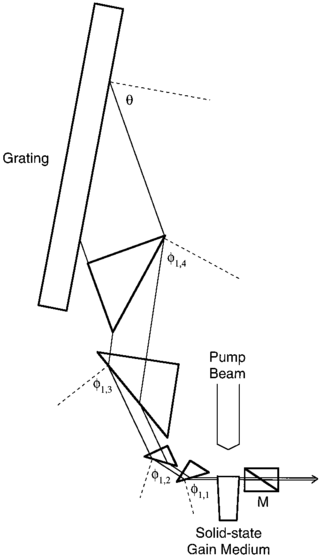Related Research Articles

A laser is a device that emits light through a process of optical amplification based on the stimulated emission of electromagnetic radiation. The word laser is an anacronym that originated as an acronym for light amplification by stimulated emission of radiation. The first laser was built in 1960 by Theodore Maiman at Hughes Research Laboratories, based on theoretical work by Charles H. Townes and Arthur Leonard Schawlow.

Spectroscopy is the field of study that measures and interprets the electromagnetic spectra that result from the interaction between electromagnetic radiation and matter as a function of the wavelength or frequency of the radiation. In simpler terms, spectroscopy is the precise study of color as generalized from visible light to all bands of the electromagnetic spectrum.

A dye laser is a laser that uses an organic dye as the lasing medium, usually as a liquid solution. Compared to gases and most solid state lasing media, a dye can usually be used for a much wider range of wavelengths, often spanning 50 to 100 nanometers or more. The wide bandwidth makes them particularly suitable for tunable lasers and pulsed lasers. The dye rhodamine 6G, for example, can be tuned from 635 nm (orangish-red) to 560 nm (greenish-yellow), and produce pulses as short as 16 femtoseconds. Moreover, the dye can be replaced by another type in order to generate an even broader range of wavelengths with the same laser, from the near-infrared to the near-ultraviolet, although this usually requires replacing other optical components in the laser as well, such as dielectric mirrors or pump lasers.

Ti:sapphire lasers (also known as Ti:Al2O3 lasers, titanium-sapphire lasers, or Ti:sapphs) are tunable lasers which emit red and near-infrared light in the range from 650 to 1100 nanometers. These lasers are mainly used in scientific research because of their tunability and their ability to generate ultrashort pulses. Lasers based on Ti:sapphire were first constructed and invented in June 1982 by Peter Moulton at the MIT Lincoln Laboratory.

A tunable laser is a laser whose wavelength of operation can be altered in a controlled manner. While all laser gain media allow small shifts in output wavelength, only a few types of lasers allow continuous tuning over a significant wavelength range.

Atomic vapor laser isotope separation, or AVLIS, is a method by which specially tuned lasers are used to separate isotopes of uranium using selective ionization of hyperfine transitions. A similar technology, using molecules instead of atoms, is molecular laser isotope separation (MLIS).

Theodor Wolfgang Hänsch is a German physicist. He received one-third of the 2005 Nobel Prize in Physics for "contributions to the development of laser-based precision spectroscopy, including the optical frequency comb technique", sharing the prize with John L. Hall and Roy J. Glauber.

A solid-state laser is a laser that uses a gain medium that is a solid, rather than a liquid as in dye lasers or a gas as in gas lasers. Semiconductor-based lasers are also in the solid state, but are generally considered as a separate class from solid-state lasers, called laser diodes.
Amplified spontaneous emission (ASE) or superluminescence is light, produced by spontaneous emission, that has been optically amplified by the process of stimulated emission in a gain medium. It is inherent in the field of random lasers.

A prism compressor is an optical device used to shorten the duration of a positively chirped ultrashort laser pulse by giving different wavelength components a different time delay. It typically consists of two prisms and a mirror. Figure 1 shows the construction of such a compressor. Although the dispersion of the prism material causes different wavelength components to travel along different paths, the compressor is built such that all wavelength components leave the compressor at different times, but in the same direction. If the different wavelength components of a laser pulse were already separated in time, the prism compressor can make them overlap with each other, thus causing a shorter pulse.

A copper vapor laser (CVL) uses vapors of copper as the lasing medium in a 4-level laser. It produces green laser light at 510.6 nm and yellow laser light at 578.2 nm. The pulse width is typically from 5 to 60 ns, and peak power from 50 to 5000 kW. Its pulse repetition frequencies can be 2 to 100 kHz. The average power of CVLs can range from 25 W to more than 2 kW.

Francisco Javier "Frank" Duarte is a laser physicist and author/editor of several books on tunable lasers.
Beam expanders are optical devices that take a collimated beam of light and expand its width.

The first description of multiple-prism arrays, and multiple-prism dispersion, was given by Newton in his book Opticks. Prism pair expanders were introduced by Brewster in 1813. A modern mathematical description of the single-prism dispersion was given by Born and Wolf in 1959. The generalized multiple-prism dispersion theory was introduced by Duarte and Piper in 1982.
Colin Edward Webb is a British physicist and former professor at the University of Oxford, specialising in lasers.
Fritz Peter Schäfer was a German physicist, born in Hersfeld, Hesse-Nassau. He is the co-inventor of the organic dye laser. His book, Dye Lasers, is considered a classic in the field of tunable lasers. In this book the chapter written by Schäfer gives an ample and insightful exposition on organic laser dye molecules in addition to a description on the physics of telescopic, and multiple-prism, tunable narrow-linewidth laser oscillators.

A solid-state dye laser (SSDL) is a solid-state lasers in which the gain medium is a laser dye-doped organic matrix such as poly(methyl methacrylate) (PMMA), rather than a liquid solution of the dye. These lasers are also referred to as solid-state organic lasers and solid-state dye-doped polymer lasers.

Multiple-prism grating laser oscillators, or MPG laser oscillators, use multiple-prism beam expansion to illuminate a diffraction grating mounted either in Littrow configuration or grazing-incidence configuration. Originally, these narrow-linewidth tunable dispersive oscillators were introduced as multiple-prism Littrow (MPL) grating oscillators, or hybrid multiple-prism near-grazing-incidence (HMPGI) grating cavities, in organic dye lasers. However, these designs were quickly adopted for other types of lasers such as gas lasers, diode lasers, and more recently fiber lasers.
Brian J. Orr is an Australian scientist known for various experimental and theoretical contributions to molecular and optical physics, including laser spectroscopy and optical parametric oscillators.

An organic laser is a laser which uses an organic material as the gain medium. The first organic laser was the liquid dye laser. These lasers use laser dye solutions as their gain media.
References
- ↑ "Piper, James Austin (Jim)". Encyclopedia of Australian Science and Innovation. Retrieved 20 September 2023.
- ↑ "Jim Piper we salute you". Macquarie University, Sydney Australia. Retrieved 20 September 2023.
- 1 2 3 4 "James Piper". Macquarie University, Sydney Australia. Retrieved 16 May 2012.
- ↑ "Deputy Vice-Chancellor (Research), Professor Jim Piper". Macquarie University, Sydney Australia. Retrieved 16 May 2012.
- ↑ F. J. Duarte and J. A. Piper, Dispersion theory of multiple-prism beam expanders for pulsed dye lasers, Opt. Commun.43, 303–307 (1982).
- ↑ F. J. Duarte and J. A. Piper, Narrow linewidth high prf copper laser-pumped dye-laser oscillators, Appl. Opt.23, 1391-1394 (1984)